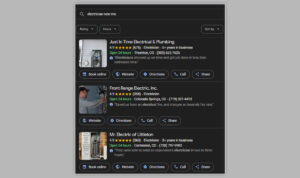Ever increasing competition means having a strong online presence is essential for businesses of all sizes. Search Engine Optimization (SEO) plays a pivotal role in improving a website’s visibility and driving organic traffic from search engine results pages (SERPs). In this blog, we’ll delve into what SEO encompasses, how it differs from paid advertising, and the key elements it entails.
via GIPHY
Distinguishing SEO from Paid Advertising
While both SEO and paid advertising aim to increase website visibility, they differ in fundamental ways:
- Cost: SEO focuses on organic traffic and does not involve direct payments to search engines. On the other hand, paid advertising (such as Pay-Per-Click or PPC) requires advertisers to pay for each click or impression generated from their ads.
- Positioning: SEO aims to achieve high organic rankings in the regular search results, also known as the “organic” or “natural” listings. Paid advertising, however, allows businesses to appear at the top of search results through sponsored ads, typically marked as “Ad” or “Sponsored.”
- Longevity: SEO efforts, when implemented correctly, can have long-lasting effects. Once a website achieves a higher ranking, it tends to sustain its position even after reducing active optimization. Paid advertising, on the other hand, stops producing results as soon as the advertising budget is exhausted, or the campaign is paused.
Key Elements of SEO
Successful SEO encompasses a variety of strategies and techniques, some of which include:
- Keyword Research: Identifying and targeting relevant keywords and phrases that potential customers are likely to search for. Keyword research involves understanding search volumes, competition, and user intent to optimize content effectively.
- On-Page Optimization: Optimizing individual web pages to improve their search engine rankings. This includes optimizing meta tags (titles, descriptions), headers, URLs, and incorporating targeted keywords naturally into content.
- Technical SEO: Optimizing the technical aspects of a website to enhance its crawlability and indexability by search engines. This involves optimizing site speed, mobile-friendliness, URL structure, XML sitemaps, and implementing schema markup.
- Content Creation: Developing high-quality, valuable, and relevant content that caters to users’ needs and aligns with targeted keywords. Engaging and shareable content helps attract inbound links and establishes authority in the eyes of search engines.
- Link Building: Acquiring high-quality backlinks from reputable websites to improve a website’s authority and trustworthiness. Link building is a vital element of SEO, but it must be done naturally and ethically to avoid penalties from search engines.
- User Experience (UX): Ensuring that a website provides a seamless and user-friendly experience. Factors such as page load speed, mobile optimization, intuitive navigation, and engaging design contribute to a positive user experience.
- Analytics and Monitoring: Implementing tools like Google Analytics to track and analyze website performance. Monitoring key metrics helps identify areas for improvement, measure the effectiveness of SEO strategies, and make data-driven decisions.
via GIPHY
Conclusion
SEO is a multifaceted approach to optimizing websites for improved visibility and organic search traffic. It involves various techniques such as keyword research, on-page optimization, technical SEO, content creation, link building, user experience, and analytics. Unlike paid advertising, SEO focuses on long-term organic growth and can be a cost-effective strategy for businesses to attract relevant
The post Understanding SEO and Paid Advertising appeared first on Koozai.com
Source: koozai.com


